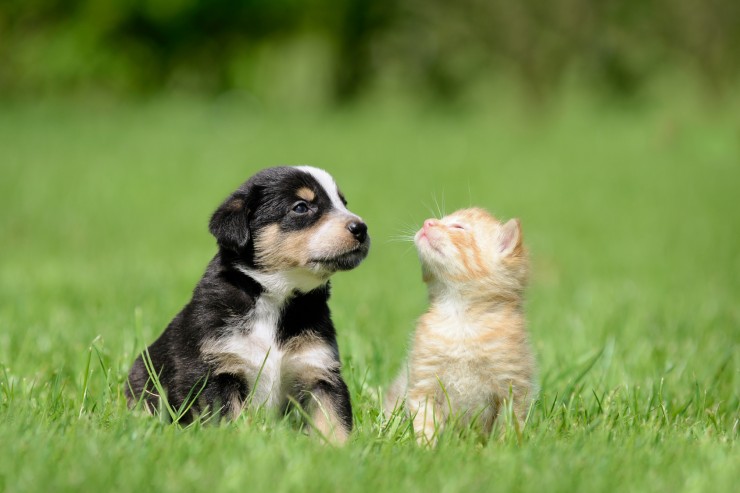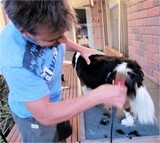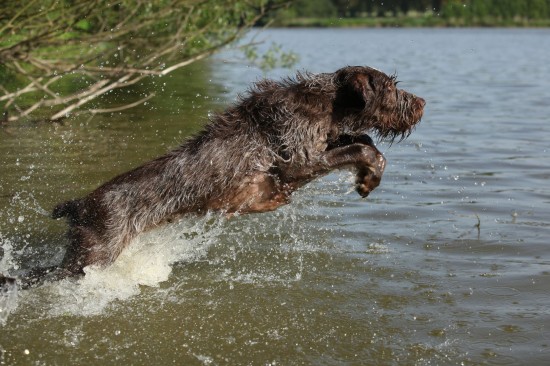The first thing you must have when attempting to house train your dog is "patience." Keep in mind that when we were young, we too had to learn where and when we could go. Bad news is, we don't have doggie diapers, but the good news is we don't have to get our dogs on a toilet seat! Also, dogs are instinctively clean animals, they would prefer to not to mess themselves or their usual eating and sleeping areas. Depending on the age of your dog, they naturally develop tendencies to go on certain surfaces like grass or dirt, use this as a stepping stone to a quicker and more successful training cycle.
Establish the Living Area with Your Dog
Help your dog establish their living area in a small confined space, maybe a bathroom, part of the kitchen or garage. Please make sure that if you plan to have your dog in a crate, make it an open environment. Some people think that putting the dog in a crate and shutting the door helps them get used to their surroundings, but it doesn't. Using a crate is OK if you let your dog live comfortably by letting them have some freedom to go in and out as they please, unless you have to leave the house for a short period of time. Keeping them locked up for long periods of time is when you should ask yourself if you are really ready to own a dog.
Take the time to work with your dog to establish their living area. Spend time playing with them in their "room" as well as let them eat and sleep here. Do your best to make their room comfortable, maybe give them a comfortable dog bed, blanket and give them a bowl of water in, or close to their space. It's possible they might still wet their space in the beginning but once they realize that their room is designated for their comfort they will do their best to avoid going in their space as long as they have regular opportunities to go to the toilet on the paper or outside.
When your dog has had the time to get comfortable with their room, you'll be able to move it around and they will follow it to wherever you decide to place it. It's important to find a place that makes them part of the family surroundings but is equally convenient for you so you don't feel they're "in the way" a dog will become part of the family in no time, trust me!
Once your dog gets to the point of sleeping in their bed feel free to confine them there by leashing them or shutting the crate door to keep them in their room, just be aware of them and ensure you can keep an eye on them. Keeping your dog on a leash unattended is not recommended anytime. Also, if you feel that you want to keep an eye on them when there awake, just keep their leash attached to your belt during your daily routine to help you identify any tendencies and help monitor their behavior.
Establish the Toilet Area with Your Dog
Help your dog establish their toilet area, at first it will probably be inside the house on some news paper, just make sure they that they have access to this area when they need it. If they do not have access to this area they will go in other places and establish their own areas, the problem being this might not be ideal for you and your family. Until they are comfortable going in the designated area, it is important that you accompany your dog every time.
The best way to gauge when your dog has to go to the toilet is to keep them on a regular eating schedule. You will start to see that when they eat at a certain time they will need to go to they toilet after an approximate amount of time, this will give you a better understanding of when they have to go. A regular eating schedule means a regular toilet schedule this will help you to plan out your day without having messy accidents everywhere. If your dog is confined too long and has to go, they will potentially go in there space and it will get increasingly more difficult to house train them.
If you have a new puppy they have a harder time controlling their bladder so you might have to take them a little more frequently, but healthy adult dogs should be able to control their bladder and bowels for about eight hours. Also, keep in mind that when new puppies get excited they might make little mistakes, make sure you don't scold them in this instance, just let them know they did it and show them the regular toilet area. Every time they go in the right place make sure you let them know they did good, this will reinforce what you're training.
As you are training your dog in the house you should be working with them outside as this is where your dog will end up going. You have to read little signs to know when they're ready to go and if convenient take them outside right away. Don't expect a puppy to bark when they need to go, they're not there yet! You will know something's up when your dog starts to get restless or starts sniffing around, they're actually looking for a spot to go. Just pick them up and take them outside, they'll do the rest, you can urge them a bit with the command that you want them to go. Again, once they go it's important to acknowledge them in a positive way so they know that this is where they must go. When they get comfortable with this they will start to ask to go out.
Some Tips
* If you follow the instructions as outlined above, your dog will be house trained in a short period of time. One way to speed up the process is to praise and reward your dog each and every time they go successfully in their toilet area. It is just as important not to scold your dog for accidents and mistakes. Reprimanding your dog usually confuses the dog and slows down the house training process.
* If you find that your dog continues to go in their allotted space, make note of how long they were there. You might find they were in there too long or they're space is a bit too big for them, giving them the room to go in the corner of they're space. You can remedy this by not leaving them there too long, establish a smaller sleep area and take them to the toilet more often.
* If you find that your dog continues to go in their bed, this might be due to being confined there too long and they couldn't help themselves, or they are still trying to understand that this is their sleep and comfort space. Again, try not to leave your dog in their space too long and try to take them to the toilet more often.
* If you find the bed wetting continuing longer than you feel is right, you might want to look at their water intake. A lot of dogs will drink water out of boredom or habit, ensure you're limiting their intake and take them out more often if possible. Also, try and keep your dog active to ensure good health and limited boredom, get them into good habits. Also, be aware that continued messing can be due to unknown medical issues like urinary tract problems for instance, try the tips above first, it's usually something simple that you might be missing.
* If your dog doesn't feel comfortable in their space and/or surroundings you might notice signs of them barking, chewing, some anxiety or whining a lot. If you feel this is happening go back over your method and ensure you're making them as comfortable and welcomed as a family member.
Remember, love, due diligence and patience on your part will make it a smooth and "clean" transition.

 Some Horse And Pony Basics - Colours, Types And Markings
Some Horse And Po
Some Horse And Pony Basics - Colours, Types And Markings
Some Horse And Po
 How To Make Sure That Your Pet Insurance Will Pay Out When You Need It To
How To Make Sure
How To Make Sure That Your Pet Insurance Will Pay Out When You Need It To
How To Make Sure
 The Temperament Differences Between Dogs And Bitches
The Temperament D
The Temperament Differences Between Dogs And Bitches
The Temperament D
 What to look for in a dog clipper
What to look for in a dog clipper
 A Detailed Description Of The Italian Spinone
A Detailed Descri
A Detailed Description Of The Italian Spinone
A Detailed Descri